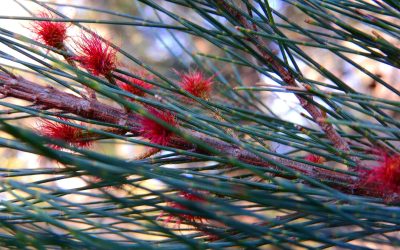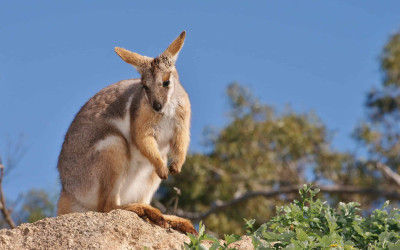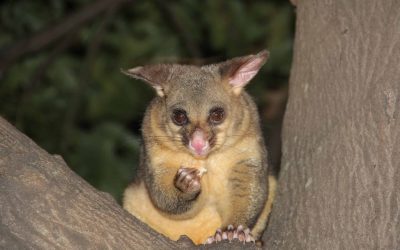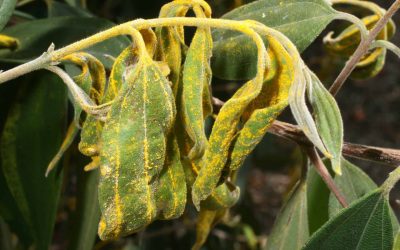MEET THE INVADERS
Rabbits
Fast and agile – the European rabbit, originally from the Iberian Peninsula (Spain and Portugal), is infamous for its ability to breed and thrive just about anywhere in the world.
With their long ears, powerful hind legs that can propel them up to 56 kilometres an hour, and their signature short, fluffy tails, rabbits belong to the lagomorph family, sharing ties with hares and pikas.
When it comes to food, these tiny bulldozers can munch through a wide variety of plants, which helps them adapt to all kinds of environments. They’re also master builders, digging complex underground burrows called warrens, which protect them from predators and help regulate body temperature.
They tend to live and forage in social groups of about 5 (3 adult females and 2 males) and have a home range of about 10–12 hectares.
What rabbits are most well known for is their incredible knack for reproduction. They breed up to 7 times a year, producing 50 to 60 young a year. This biological superpower has played a big role in their success, especially where there are no predators, like wild cats.
Invasion story
It took a surprisingly long time – about 70 years – for rabbits to truly get a foothold in Australia.
5 domesticated rabbits were brought over with the First Fleet in 1788 and others followed later, destined for dinner plates or hunting sport. Occasionally, rabbits escaped or were deliberately released. In places like Queensland and South Australia hunting bans even protected them during certain seasons. Yet, for decades, local populations failed to thrive, despite these early introductions. But then, something shifted.
In 1859 a pastoralist released a few wild-type rabbits at Barwon Park, near Geelong, Victoria, with genetic traits that gave them a crucial edge in the wild. Only 3 years later, the local newspaper reported 20,000 rabbits shot on the Barwon Park property alone – an astonishing tally.
Squatting in native animal burrows and with warmer winters, Australia was the perfect climate for the upcoming rabbit plague.
During the 1860s, their numbers exploded, spreading through Victoria. By the 1880’s they’d reached New South Wales, Queensland and South Australia. Western Australia fell to the invasion in 1895.
But they didn’t rise to domination on their own. Their explosion coincided with the destruction of natural predators. Beginning in the 1850s, the widespread use of strychnine wiped out dingoes and quolls over vast areas. Hunting also took a toll – at Barwon Park, more than 3,000 quolls and 800 raptors were killed between 1861 and 1864. Quolls faced even greater challenges from diseases introduced by humans and the arrival of foxes.
Rabbits had claimed 70% of Australia’s suitable land, with their population allegedly soaring into the billions by the 1920’s.
And Australia went crazy trying to keep their numbers at bay, building long ‘rabbit proof’ fences, trapping, killing, poisoning and eating them.
But nothing seemed to work at the scale needed. In fact, by the 1940s an estimated 600 million rabbits still hopped around Australia.
Then came a glimmer of hope.
In 1950 the CSIRO released the myxoma virus. It was a world-first success in biological control, dramatically reducing rabbit populations. At its peak, it killed over 99% of infected rabbits. In some places this reduced rabbit numbers by more than 90%, recovering the landscape and giving Australia’s wildlife and agriculture some breathing room.
But by the late 1950s, it was clear this was an evolutionary arms race.
Rabbits began adapting to the virus and numbers began creeping up again, although they never returned to pre-1950 levels.
In 1996, the CSIRO introduced a new weapon: rabbit hemorrhagic disease virus (RHDV). It caused another massive reduction in rabbit numbers, especially in arid areas, and kept populations low for over a decade. However, resistance eventually began to emerge.
By 2015, a new strain, RHDV2, appeared. The way it arrived in Australia is unknown. Within 18 months, this strain had spread across the country, reducing wild rabbit populations by an average 60%.
Today, feral rabbits occupy about 70% of Australia. The latest population estimate is around 200 million.
How did we get here?
In the early stages of rabbit introduction, there was little anticipation of the environmental disaster that would unfold. Rabbits were initially protected to promote hunting, with some regions implementing hunting bans during certain seasons to preserve their numbers.
Rabbit trappers – keen to ensure future work in the fur trade – helped the spread.
In the late 1800s, states implemented different legislation in response to growing concerns over the spread. South Australia, for example, implemented their Rabbit Destruction Act in 1875 and in Queensland, a Rabbit Nuisance Bill was introduced in 1878.
Then came the concept of ‘rabbit-proof’ fencing. In 1886 Queensland commenced building its fence and in the early 1900s West Australia followed. But these proved unsuccessful at keeping them out.
In 1999, the Australian Government developed the first national plan to address the impact of rabbits on the environment. This has been revised multiple times, with the latest version released in 2016.
A 2013 review of the threat abatement plan for feral rabbits found that programs had ‘often been ad hoc, lacked strategic prioritisation’ and were rarely focused on threatened species and ecological communities.
But there have been wins – particularly through biocontrol. The introduction of RHDV1 has had a dramatic effect on control efforts.
Despite this, Australia still has a serious rabbit problem. Recently, there has been a serious decline in the number of people working on rabbit issues in governments.
Rabbits are one of the costliest invaders Australia has ever tried to control, next to feral cats and fire ants.
The toll on nature
European rabbits may seem cute and harmless, but their impacts on Australia’s environment have been devastating.
Their insatiable appetites have led rabbits to become the single greatest cause of species decline – a threat to more than 300 nationally listed species. Australian plants have not evolved to copy with such intense rabbit browsing.
Even in small numbers, their effects can be profound. A density of just 1 rabbit per 2 hectares is often enough to stop some native plants from growing back, leading to local plant extinctions and widespread environmental destruction.
They also compete with native animals for food and shelter, especially small to medium-sized mammals, like the yellow-footed rock wallaby and bilbies. This is worsened during drought or after fires when food is scarce.
But despite their big appetites, they’re not eating everything in sight. They avoid unpalatable weeds, allowing invasive weeds to take over, while some native species struggle to survive. The result is a chain reaction: declining plant diversity and bare soils vulnerable to erosion.
If that wasn’t enough, rabbits can also increase the impact of feral cats and foxes, serving as a major food source to sustain their population numbers.
Rabbits have significantly impacted various national parks and World Heritage areas across Australia. In Uluru-Kata Tjuta National Park in the Northern Territory, rabbits almost took over a fenced reserve for the protection of the endangered mala.
Macquarie Island has also historically suffered extensive damage but thankfully, a successful eradication program was completed in 2014.



Cultural Consequences
The rabbit invasion has had a detrimental effect on Indigenous culture. The loss of native plants and animals has disrupted traditional hunting practices and food sources. The degradation of the land has also impacted sacred sites and the spiritual connection Indigenous communities have with their environment. For example, the Diyari people of northeastern South Australia suffered the loss of edible plants they traditionally relied on and rabbits undermined their traditional burning practices.
How do we fix this?
Tackling the rabbit plague takes more than one approach – it’s a battle of strategy, persistence, and innovation.
In addition to biocontrol, various physical methods are being used to tackle rabbits, including:
- Warren destruction: Ripping and fumigating burrows to disrupt breeding and shelter.
- Fencing: Keeping rabbits out of high-priority areas.
- Poison baiting and shooting: Reducing rabbit numbers in targeted regions.
- Island eradications: Successfully removing rabbits from islands like Macquarie Island has led to remarkable recovery for native plants and wildlife.
But if we’re serious about managing rabbits long-term, we need to stay ahead of their ability to adapt, while addressing the gaps in current control efforts. This includes:
- Investing in cutting-edge biological control
Biological control is still the most cost-effective way to manage rabbits at scale, but it requires constant innovation. Research is now focused on improving existing viruses and developing new strains to stay ahead in the evolutionary arms race between rabbits and pathogens. Maintaining low rabbit numbers over time is critical to protecting both Australia’s biodiversity and its rural industries. - Combine methods for lasting impact
Biocontrol alone isn’t enough – experience with myxoma virus and RHDV shows that populations eventually bounce back. An integrated approach is essential, combining biocontrol with on-ground techniques like habitat modification. - Prioritise native species
Agricultural damage often takes centre stage in rabbit control, but the impact on native wildlife is just as urgent. Funding and clear valuation of Australia’s precious species must be built into management strategies to ensure environmental recovery remains a priority. - Research funding
Rabbits are remarkably adaptable, and their resilience demands persistent effort. This requires secure, long-term funding for research, monitoring and coordinated action.
Today, rabbits continue to destroy landscapes and threaten Australia’s unique wildlife. The tools to manage them exist – but to win this battle, we need strategic, sustained and collaborative action.
FAQs
Rabbits were first brought to Australia with the First Fleet in 1788. Early releases were frequent and occurred in every colony. However, rabbits did not become a huge problem until the 1860s. The rapid spread of rabbits across Australia was likely facilitated by low predation pressure following the decline of native predators, such as quolls, due to disease and persecution by European settlers. Genetic analysis has shown that Australian rabbits are descended from a small number of individuals with wild ancestry, which likely made them better adapted to local conditions than earlier releases of domesticated rabbits.
Rabbits have had a devastating impact on Australia’s unique wildlife. Their grazing destroys native plants and degrades landscapes, impacting environmental function. Rabbits compete with native wildlife for food and resources and their burrowing contributes to soil erosion.
Various methods have been employed to control rabbit populations in Australia, including biological control, warren destruction and exclusion fencing. The introduction of myxomatosis in the 1950s and rabbit hemorrhagic disease (RHD) in the 1990s have been the most effective control measures to date, however, resistance to these has become an issue. Ongoing research is focusing on improving the effectiveness of biological control agents and developing integrated management strategies to ensure the long-term sustainability of rabbit control efforts.
Australian Government Department of Agriculture, Water and the Environment. (n.d.). Andropogon gayanus (gamba grass). Retrieved from https://profiles.ala.org.au/opus/weeds-australia/profile/Andropogon%20gayanus
Northern Territory Government. (2022). Protecting people and the environment: Containing and eradicating dangerous gamba grass infestations in the Northern Territory.
Setterfield, S. A., Rossiter-Rachor, N. A., & Adams, V. M. (2018). Navigating the fiery debate: The role of scientific evidence in eliciting policy and management responses for contentious plants in northern Australia. Retireved from https://doi.org/10.1071/PC18028
Williams, G. & McLellan, L. (2022). The ecological consequences of invasive grasses on fire regimes in Australia. Journal of Environmental Management. Available at: https://doi.org/10.1016/j.jenvman.2022.116785
Invasive Species Council. (2008). Queensland bans gamba grass: Feral Herald, Volume 1, Issue 18.
Australian Government Department of Climate Change, Energy, the Environment and Water. (2023). Northern Australia Introduced Grasses. Retrieved from https://www.dcceew.gov.au/sites/default/files/env/pages/99dfad7e-9feb-4da1-826b-fdf5740ffa5e/files/northern-australia-introduced-grasses.pdf
Country Needs People. (2023). Gamba grass: A massive threat to biodiversity, safety and culture. Retrieved from https://www.countryneedspeople.org.au/gamba_grass_massive_threat_to_biodiversity_safety_and_culture
Rossiter, N. A., et al. (2003). Gamba grass and fire intensity in northern Australia. Pacific Conservation Biology, 24(3), 318-328. https://doi.org/10.1046/j.1472-4642.2003.00020.x
Setterfield, S. A., et al. (2010). Impact of gamba grass on fire regimes and biodiversity in northern Australia. Pacific Conservation Biology, 24(3), 318-328. https://doi.org/10.1111/j.1472-4642.2010.00688.x
Chaseling, O. (2023, February 26). Report recommends urgent expansion of gamba grass eradication zone as Litchfield National Park faces growing threat. ABC News. https://www.abc.net.au/news/2023-
Department of Environment, Parks and Water Security. (2021, November). Cycas armstrongii. Northern Territory Government. https://nt.gov.au/__data/assets/pdf_file/0017/208430/cycas-armstrongii.pdf
Northern Territory Department of Environment, Parks and Water Security. (2021). Cycas armstrongii.
Department of Climate Change, Energy, the Environment and Water (DCCEEW) 2021, Threat abatement plan to reduce the impacts on northern Australia’s biodiversity by the five listed grasses: Review 2012–2021, Australian Government, Canberra, viewed 15 April 2025, https://www.dcceew.gov.au/sites/default/files/documents/tap-reduce-impacts-northern-australias-biodiversity-five-listed-grasses-review-2012-2021.pdf.
Lonsdale, WM 2004, ‘Predicting the spread of invasive species: the influence of environmental resistance, propagule pressure and the Allee effect’, in B Sindel & S Johnson (eds), Proceedings of the 14th Australian Weeds Conference, Wagga Wagga, NSW, 6–9 September 2004, Weed Society of New South Wales, Sydney, pp. 168–171, viewed 15 April 2025, https://caws.org.nz/old-site/awc/2004/awc200411681.pdf.
Department of Climate Change, Energy, the Environment and Water (DCCEEW) 2021, Threat abatement plan to reduce the impacts on northern Australia’s biodiversity by the five listed grasses: Review 2012–2021, Australian Government, Canberra, viewed 15 April 2025, https://www.dcceew.gov.au/sites/default/files/documents/tap-reduce-impacts-northern-australias-biodiversity-five-listed-grasses-review-2012-2021.pdf.
Australian Government Department of Agriculture, Water and the Environment. (n.d.). Andropogon gayanus (gamba grass). Retrieved from https://profiles.ala.org.au/opus/weeds-australia/profile/Andropogon%20gayanus
Northern Territory Government. (2022). Protecting people and the environment: Containing and eradicating dangerous gamba grass infestations in the Northern Territory.
Setterfield, S. A., Rossiter-Rachor, N. A., & Adams, V. M. (2018). Navigating the fiery debate: The role of scientific evidence in eliciting policy and management responses for contentious plants in northern Australia. Retireved from https://doi.org/10.1071/PC18028
Williams, G. & McLellan, L. (2022). The ecological consequences of invasive grasses on fire regimes in Australia. Journal of Environmental Management. Available at: https://doi.org/10.1016/j.jenvman.2022.116785
Invasive Species Council. (2008). Queensland bans gamba grass: Feral Herald, Volume 1, Issue 18.
Australian Government Department of Climate Change, Energy, the Environment and Water. (2023). Northern Australia Introduced Grasses. Retrieved from https://www.dcceew.gov.au/sites/default/files/env/pages/99dfad7e-9feb-4da1-826b-fdf5740ffa5e/files/northern-australia-introduced-grasses.pdf
Country Needs People. (2023). Gamba grass: A massive threat to biodiversity, safety and culture. Retrieved from https://www.countryneedspeople.org.au/gamba_grass_massive_threat_to_biodiversity_safety_and_culture
Rossiter, N. A., et al. (2003). Gamba grass and fire intensity in northern Australia. Pacific Conservation Biology, 24(3), 318-328. https://doi.org/10.1046/j.1472-4642.2003.00020.x
Setterfield, S. A., et al. (2010). Impact of gamba grass on fire regimes and biodiversity in northern Australia. Pacific Conservation Biology, 24(3), 318-328. https://doi.org/10.1111/j.1472-4642.2010.00688.x
Chaseling, O. (2023, February 26). Report recommends urgent expansion of gamba grass eradication zone as Litchfield National Park faces growing threat. ABC News. https://www.abc.net.au/news/2023-
Department of Environment, Parks and Water Security. (2021, November). Cycas armstrongii. Northern Territory Government. https://nt.gov.au/__data/assets/pdf_file/0017/208430/cycas-armstrongii.pdf
Northern Territory Department of Environment, Parks and Water Security. (2021). Cycas armstrongii.
Department of Climate Change, Energy, the Environment and Water (DCCEEW) 2021, Threat abatement plan to reduce the impacts on northern Australia’s biodiversity by the five listed grasses: Review 2012–2021, Australian Government, Canberra, viewed 15 April 2025, https://www.dcceew.gov.au/sites/default/files/documents/tap-reduce-impacts-northern-australias-biodiversity-five-listed-grasses-review-2012-2021.pdf.
Lonsdale, WM 2004, ‘Predicting the spread of invasive species: the influence of environmental resistance, propagule pressure and the Allee effect’, in B Sindel & S Johnson (eds), Proceedings of the 14th Australian Weeds Conference, Wagga Wagga, NSW, 6–9 September 2004, Weed Society of New South Wales, Sydney, pp. 168–171, viewed 15 April 2025, https://caws.org.nz/old-site/awc/2004/awc200411681.pdf.
Department of Climate Change, Energy, the Environment and Water (DCCEEW) 2021, Threat abatement plan to reduce the impacts on northern Australia’s biodiversity by the five listed grasses: Review 2012–2021, Australian Government, Canberra, viewed 15 April 2025, https://www.dcceew.gov.au/sites/default/files/documents/tap-reduce-impacts-northern-australias-biodiversity-five-listed-grasses-review-2012-2021.pdf.








